
|
Astronomy Picture Of the Day (APOD)
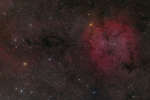 IC 1396 and Surrounding Starfield
IC 1396 and Surrounding Starfield
19.08.2009
Sprawling across hundreds of light-years, emission nebula IC 1396, visible on the upper right, mixes glowing cosmic gas and dark dust clouds. Stars are forming in this area, only about 3,000 light-years from Earth. This wide angle view also captures surrounding emission and absorption nebula.
 The Milky Way Over the Badlands
The Milky Way Over the Badlands
18.08.2009
Why take a picture of just the Badlands when you can take one that also shows the spectacular sky above it? Just such a picture, actually a digital stitched panorama of four images, was taken in late June near midnight, looking southwest.
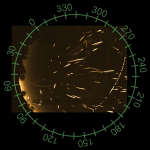 Perseids from Perseus
Perseids from Perseus
17.08.2009
Where are all of these meteors coming from? In terms of direction on the sky, the pointed answer is the constellation of Perseus. That is why the last week's meteor shower was known as the Perseids -- the meteors all appear to come from a radiant toward Perseus.
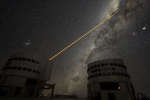 A Laser Strike at the Galactic Center
A Laser Strike at the Galactic Center
16.08.2009
Why are these people shooting a powerful laser into the center of our Galaxy? Fortunately, this is not meant to be the first step in a Galactic war. Rather, astronomers at the Very Large Telescope (VLT) site in Chile are trying to measure the distortions of Earth's ever changing atmosphere.
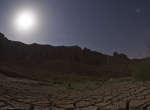 Meteor by Moonlight
Meteor by Moonlight
15.08.2009
Dark skies are favored for viewing meteor showers. But the annual Perseid Meteor Shower still entertained skygazers around the world this week even though the Moon brightened the night. At its last quarter phase...
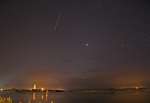 Shuttle and Meteor
Shuttle and Meteor
14.08.2009
This early morning skyscape was captured last week on August 4th, looking northeast across calm waters in the Turn Basin at NASA's Kennedy Space Center. In a striking contrast in motion, the space...
 Block Island Meteorite on Mars
Block Island Meteorite on Mars
13.08.2009
What is this strange rock on Mars? Sitting on a smooth plane, the rock stands out for its isolation, odd shape, large size and unusual texture. The rock was discovered by the robotic Opportunity rover rolling across Mars late last month. Pictured above, Opportunity prepares to inspect the unusual rock.
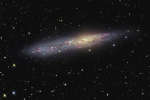 Irregular Galaxy NGC 55
Irregular Galaxy NGC 55
12.08.2009
Irregular galaxy NGC 55 is thought to be similar to the Large Magellanic Cloud (LMC). But while the LMC is about 180,000 light-years away and is a well known satellite of our own Milky Way Galaxy, NGC 55 is more like 6 million light-years distant and is a member of the Sculptor Galaxy Group.
 Inside Barringer Meteor Crater
Inside Barringer Meteor Crater
11.08.2009
What happens when a meteor hits the ground? Usually nothing much, as most meteors are small, and indentations they make are soon eroded away. About 50,000 years ago, however, a large meteor created Barringer Meteor Crater in Arizona, USA. Also known simply as Meteor Crater, the resulting impact basin spans over a kilometer.
 Moonbow and Rainbows Over Patagonia
Moonbow and Rainbows Over Patagonia
10.08.2009
Have you ever seen a moonbow? Just as rainbows are lit by the Sun, moonbows are lit by the Moon. Since the Sun is so much brighter than the Moon, sunlit rainbows are much brighter and more commonly seen than moonbows.
|
January February March April May June July August September October November December |
|||||||||||||||||||||||||||||||||||||||||||||||||